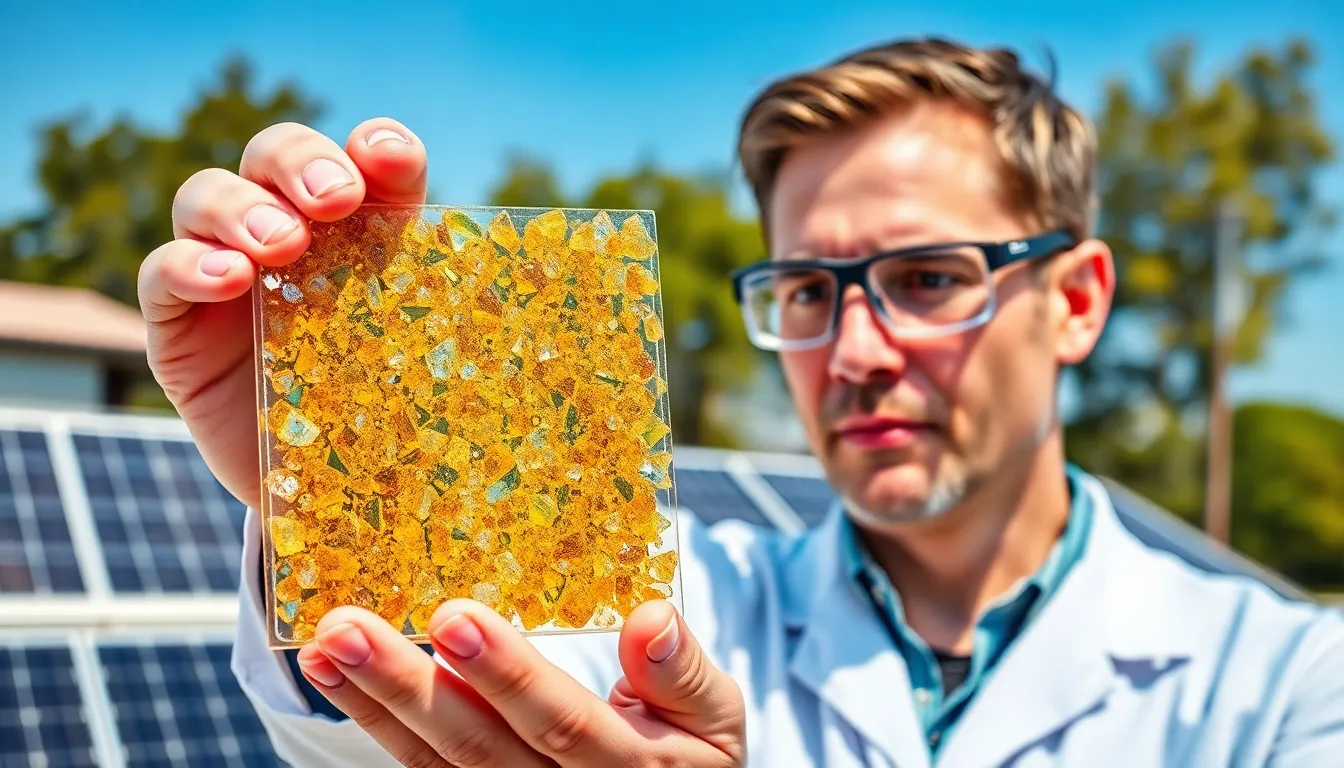In the quest for sustainable energy solutions, perovskite solar cells have emerged as a game-changer. These innovative materials promise higher efficiency and lower production costs compared to traditional silicon-based solar cells. Their unique crystal structure allows for exceptional light absorption and easy fabrication, making them a focal point in renewable energy research.
As the world shifts towards greener technologies, understanding the potential of perovskite solar cells is crucial. They not only offer a pathway to more affordable solar energy but also present an exciting opportunity for advancements in energy storage and conversion. With ongoing developments in this field, it’s clear that perovskite solar cells could play a pivotal role in shaping the future of clean energy.
Table of Contents
ToggleOverview of Perovskite Solar Cells
Perovskite solar cells utilize a unique crystal structure that enhances light absorption and simplifies fabrication processes. Their composition typically involves a hybrid organic-inorganic material, allowing for rapid development and tunable properties. These cells achieve efficiencies exceeding 25%, surpassing traditional silicon-based solar cells.
Perovskite materials commonly include methylammonium lead iodide or other combinations, tailored to optimize performance. Their production costs remain significantly lower, attributed to solution-processing techniques that reduce manufacturing complexity.
The stability of perovskite solar cells has been a focal point in recent research. Various encapsulation methods and material improvements aim to enhance durability and longevity, aiming for lifespans comparable to silicon alternatives. Field tests demonstrate promising results, with outdoor stability improving over recent years.
Applications for perovskite technology extend beyond solar cells. Perovskite materials show potential in tandem solar cell configurations, boosting overall efficiency. Their suitability for integration with existing photovoltaic technologies demonstrates versatility. Leading institutions actively research advancements, positioning perovskites as pivotal in the transition to sustainable energy solutions.
Advantages of Perovskite Solar Cells

Perovskite solar cells offer significant advantages that position them as a leading technology in the solar energy sector. Their unique properties result in higher efficiency and lower production costs compared to traditional options.
Efficiency and Performance
Perovskite solar cells achieve efficiencies exceeding 25%, making them highly competitive with silicon-based cells. Their unique crystal structure enhances light absorption, enabling better energy conversion. Studies from institutions like the National Renewable Energy Laboratory (NREL) indicate that their performance improves rapidly with advances in materials and processing techniques. Additionally, increased stability through innovative encapsulation methods enhances their performance in real-world conditions.
Cost-Effectiveness
Cost-effective production distinguishes perovskite solar cells from traditional solar technologies. Utilizing solution-processing techniques reduces material waste and simplifies manufacturing. Reports from various research initiatives show that perovskite cells can be produced at less than half the cost of silicon cells, potentially lowering the overall cost of solar energy systems. As market demand for affordable solar solutions grows, perovskite technology is positioned to meet these economic challenges effectively.
Challenges Facing Perovskite Solar Cells
Perovskite solar cells face significant challenges that impact their commercial viability. Key issues include stability problems and environmental concerns, particularly regarding lead toxicity.
Stability Issues
Stability issues in perovskite solar cells stem from environmental factors such as moisture, heat, and UV radiation. Research indicates that these cells degrade more rapidly under humid conditions compared to traditional silicon cells, leading to efficiency losses over time. Various studies show that encapsulation techniques, including polymer coatings and hermetic sealing, can improve moisture resistance, yet challenges remain in ensuring long-term performance. Laboratory studies report short-term stability improvements, but field tests reveal a gap in maintaining efficiency during prolonged exposure to real-world conditions. Developing more robust materials and protective strategies remains crucial for enhancing the longevity of perovskite solar cells.
Lead Toxicity Concerns
Lead toxicity presents a significant environmental and health concern for perovskite solar cells. These cells typically incorporate lead-based compounds, raising fears about potential leaching into the environment upon degradation. Although several research efforts focus on developing lead-free alternatives, achieving similar efficiency levels remains challenging. Regulatory bodies are increasingly scrutinizing perovskite technology due to these concerns. Studies reveal that while lead concentration in waste can be managed, the public’s perception of risk impacts market acceptance. Ongoing research aims to mitigate lead’s environmental impact through advanced recycling methods and safe disposal strategies, addressing both performance and safety challenges.
Recent Advances in Perovskite Solar Cells
Recent advancements in perovskite solar cells focus on material innovations and scalability developments aimed at improving efficiency and production.
Material Innovations
Material innovations play a crucial role in enhancing the performance of perovskite solar cells. Researchers are actively exploring new compositions, such as tandem perovskite-silicon structures, which have achieved efficiencies above 30% by combining the strengths of both materials. Additionally, novel organic-inorganic hybrid materials, including formamidinium and cesium-based perovskites, demonstrate improved thermal and moisture stability. Hybrid approaches, utilizing two-dimensional materials like graphene, also show promise in boosting charge transport and efficiency. These material developments contribute to creating more robust and high-performing solar cells that maintain efficiency even under varying environmental conditions.
Scalability Developments
Scalability developments focus on enabling large-scale production of perovskite solar cells while maintaining low costs and high quality. Innovative production methods, such as roll-to-roll processing and inkjet printing, facilitate the rapid manufacturing of large surfaces with perovskite layers. These techniques reduce waste and increase overall efficiency in production lines. Furthermore, advancements in module fabrication, including the use of flexible substrates, allow for diverse applications, from building-integrated photovoltaics to portable solar solutions. As these scalability developments progress, the potential for widespread commercial adoption of perovskite solar cells increases, positioning them as key players in the renewable energy market.
Future Prospects for Perovskite Solar Cells
Future advancements in perovskite solar cells show promising potential to revolutionize the solar energy landscape. Research continues to focus on enhancing stability, efficiency, and scalability of these cells, driving them closer to commercial viability.
Efforts to improve stability involve developing encapsulation methods and alternative materials. Advanced encapsulation techniques enhance moisture resistance and thermal stability, extending the operational lifespan of perovskite cells. Innovative research on lead-free alternatives strives to match efficiency levels while eliminating toxicity concerns, contributing to sustainable solar technology.
Efficiency improvements remain a priority, with tandem structures gaining attention. Tandem perovskite-silicon cells have reached efficiencies over 30%, significantly surpassing traditional silicon-based solar technologies. Research into new organic-inorganic hybrids aims to leverage superior light absorption and conversion properties, optimizing energy output.
Scalability also plays a crucial role in the future of perovskite solar cells. Manufacturing methods like roll-to-roll processing and inkjet printing enable rapid production and reduce costs. These techniques maintain high quality while meeting increasing market demand for affordable solar solutions.
Integration prospects with existing photovoltaic technologies, such as BIPV (building-integrated photovoltaics), broaden application possibilities. As perovskite solar cells evolve toward long-term stability and economic viability, they stand to capture significant market share in global renewable energy efforts. Research continues to emphasize overcoming challenges, ensuring that perovskite technology fulfills its potential as a key contributor to sustainable energy solutions.
Perovskite solar cells represent a transformative leap in solar technology. Their impressive efficiency and cost-effectiveness position them as strong contenders against traditional silicon-based cells. As research continues to address stability and environmental concerns, the potential for widespread adoption grows.
Innovations in materials and production techniques are paving the way for enhanced performance and scalability. The integration of perovskite technology with existing systems further expands its applications, making it a versatile component in the renewable energy landscape.
With ongoing advancements, perovskite solar cells are set to play a crucial role in the transition to sustainable energy solutions, promising a brighter and more affordable future for solar power.


